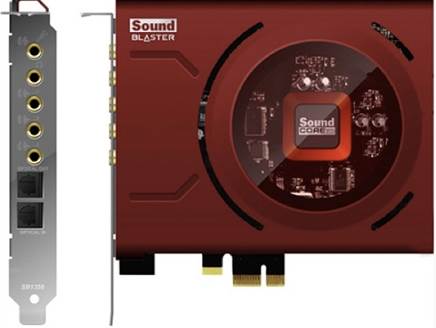ZxR is amazing for gamers who also want to
enjoy the high-quality music playback.
Sound Blaster ZxR of Creative uses the same
SoundCore3D microprocessor as we saw on last year's Recon3D gaming line of
sound cards, and has dedicated inputs for audio recording from the usual 3.5mm
microphone and line inputs. It also comes with a daughterboard that provides
optical S/PDIF inputs and outputs, and a pair of RCA inputs. Sound Blaster ZxR doesn’t
try to compete with the products of M-Audio in the audio production market
because it lacks XLR or multiple TRS inputs, but its RCA inputs mean you can
connect the output from other recording equipment or an existing hi-fi system.
Even the daughterboard has its own SoundCore3D microprocessor to apply audio
effects and process the inputs of the daughterboard. You won't need a separate
expansion slot for the daughterboard, but you will need a slot on the
backplane.
Appropriate balance
The main Sound card requires a PCI-E x1
slot. On its I/O panel, you will see a 1/4in stereo TRS microphone input and a 1/4in
TRS headphone output with a pre-installed headphone amplifier which has the
ability to provide electricity to the studio headphones with 600ohm impedance. It
has 1 dedicated TPA6120A2 op-amp, like other op-amps on the card, can be
replaced if you like the audio features of op-amp chip.

Sound
Blaster ZxR of Creative uses the same SoundCore3D microprocessor.
A stereo pair of RCA that outputs audio to
your speakers uses NJM2114D and LME49710 op-amps. Creative hasn't neglected 5.1
surround sound for game and movie enthusiasts. Two stereo outputs that shares
another NJM2114 and LME49710NA op-amp combination lets you connect rear and
center speakers. A Texas Instruments Burr-Brown PCM1794 DAC with 127dB signal-to-noise
(SNR) ratio provides headphone jack and RCA outputs while 2 PCM1798 DACs are
used for 3.5mm rear and center stereo surround outputs. Everything is connected
to a Creative SoundCore3D audio microprocessor, which can be seen through a
hole in the card’s decorative EM shield.
The final part of ZxR is an external module
designed to connect to a headphone and ¼ in stereo TRS microphone ports. The ¼
in jack connectors are actually the screw-on converters attached to the 3.5mm
jacks, so external module can be connected to other audio devices theoretically
although it’s the only compatible soundcard released until now. The TRS jacks
are labeled to show which one will connect to the mic inputs and which one
should connect to the headphone output. At the other side of the f1.5m-length
fabric-wrapped cable is the control module dominated by a convenient headphone
volume knob.
There are 3.5mm and 1/4in mic and headphone
ports, so you don’t need the back of the PC every time you want to plug your
headphones in. there is also built-in mic, so you can chat even if you want to
use integrated non-mic headphones, which is pretty convenient if you like to
use a pair of light in-ear headphones for gaming instead of a bulky headset.

The
final part of ZxR is an external module designed to connect to a headphone and
¼ in stereo TRS microphone ports.
You can't use the 3.5mm and 1/4in
connectors simultaneously, but a software switch on Creative's Pro Studio
control panel lets you switch between using the sound card's speaker and
headphone outputs. You can also use this screen to switch between standard and
high gain modes, depending on whether you're using standard consumer headphones
or a pair of high impedance studio headphone. We were surprised to find that
there's no virtual surround sound available for headphone users. You'll need
one of Creative's Recon3D sound card line if you need that feature. However,
the Scout mode to make enemy movements more audible while playing games is
available in the Pro Studio control panel.
The sound quality though both RCA and
headphones outputs is excellent. There is a stable presence of bass, along with
plenty of treble and mid-range detail. We appreciated the excellent sense of
space and separation that was really suitable to orchestral recordings and live
studio. There's not much to choose between the quality of modern dedicated
sound card configurations, but when talking about music playback, we think it’s
better than Recon3D.

The
sound quality though both RCA and headphones outputs is excellent
Recording quality is also amazing. We
really appreciated having proper RCA inputs so we could connect the analogue
outputs from a mixing or DJ console for recording. The optical S/PDIF input helps
you to take perfect digital audio samples from devices such as DVD players with
an S/PDIF output easily. This is very helpful if you're making sample patches
or recording live mixes, especially if you're recording audio from old analogue
equipment, making it a good choice for anyone who wants to digitize vinyl
played on their existing record player. However, the ZxR isn't very useful for
instrumentalists due to lack of microphone and instrument inputs. The early
review sample of the sound card we tested also lacks low-latency ASIO drivers,
which are needed for serious music production.
Card choosing
It's a little difficult to determine the
ZxR's ideal position, but it’s still an excellent sound card. It's best for
listening to high quality audio, but we love the external connection dongle and
its multiple connections that let us chat during games without a bulky headset.
It’s the best for music enthusiasts to use a high-end DAC such as the Arcam
rPAC, but if you love your music, want to play games and record audio from
other sources, the ZxR is a great bargain.
|
General info
·
Price: $314
·
Rating: 5/5
Technical specs
·
Audio microprocessor: 2x Creative SoundCore3D
·
Maximum sample rate: 96kHz
·
Maximum bit depth: 24bit
·
Port: 1/4in TRS headphone output, 1/4in TRS
mic input, stereo phono output, 3.5mm rear and center stereo surround
outputs, optical S/PDIF output and input, stereo phono input
·
Warranty: 1-year RTB
|